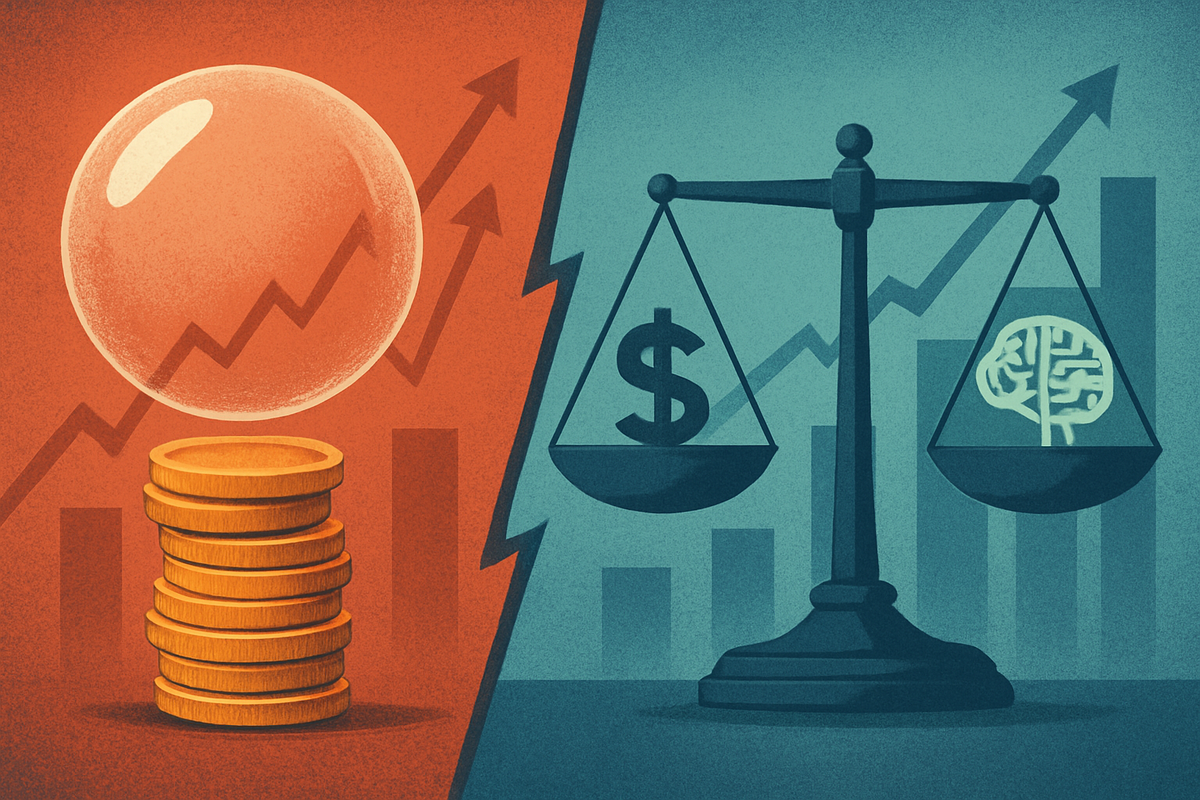
The financial world is abuzz with an increasingly fervent debate: are current stock market valuations a testament to robust economic fundamentals and corporate strength, or are they inflated beyond sustainable levels, signaling an impending correction? As of late October 2025, investors, analysts, and economists are sharply divided, grappling with a complex interplay of historical metrics, economic forecasts, and the ever-present influence of interest rates. This intensifying discussion holds immediate implications for investment strategies, risk assessment, and the broader economic outlook, prompting a critical examination of what truly underpins the market's current pricing.
This article delves into the core of this financial conundrum, dissecting the compelling arguments from both sides. We will explore key valuation metrics such as Price-to-Earnings (P/E) ratios, the cyclically adjusted Shiller CAPE ratio, and the renowned Buffett Indicator, comparing today's market landscape to historical averages and past speculative bubbles. Understanding these divergent perspectives is crucial for any investor navigating the current volatile waters, as the resolution of this debate will profoundly shape market performance and investment opportunities in the months and years to come.
The Alarming Signals: Arguments for Overvaluation
A significant contingent of market observers points to several key indicators suggesting that the stock market is treading on dangerously overvalued ground. The primary concern revolves around elevated P/E ratios. The S&P 500's trailing twelve-month P/E ratio, hovering around 31-32 as of late October 2025, and its forward P/E at approximately 23-24, stand notably higher than historical averages. For context, the mean S&P 500 trailing P/E is typically closer to 16.18, with a median of 15.06, indicating that investors are currently paying a substantial premium for corporate earnings compared to historical norms.
Further exacerbating these concerns is the Cyclically Adjusted P/E (CAPE) ratio, also known as the Shiller P/E. This metric, which smooths out earnings volatility over a decade, reached an alarming 39.8 in the third quarter of 2025. This figure is the second-highest reading in over 140 years, approaching levels last seen just before the dot-com bust of 2000. Such elevated CAPE ratios historically precede periods of lower long-term returns, prompting fears that investors are setting themselves up for disappointment.
Adding weight to the overvaluation argument is the "Buffett Indicator," Warren Buffett's preferred metric of total market capitalization to GDP. This indicator has soared to an unprecedented 217-218% of GDP, far surpassing the 160% peak during the dot-com bubble and the 200% level that prompted Buffett to warn of investors "playing with fire." Some analyses suggest the market is currently overvalued by over 100% based on this metric. Moreover, a significant portion of recent stock price appreciation, particularly in mid- and small-cap stocks, is attributed to a "valuation re-rating" rather than proportional earnings growth, implying that investors are simply paying more for the same underlying earnings, artificially inflating multiples.
The Counter-Narrative: Arguments for Justified Valuations
Despite the red flags raised by traditional metrics, another school of thought posits that current stock market valuations are, in fact, justifiable, or at least not as precarious as historical comparisons might suggest. A cornerstone of this argument is the prevailing interest rate environment. Historically, lower interest rates tend to bolster higher stock market valuations by reducing the cost of capital for businesses and making fixed-income investments less appealing, thereby channeling more capital into equities. While interest rates have seen recent increases, long-term yields remain within a range that has historically supported higher P/E multiples. Furthermore, expectations of future rate cuts by the Federal Reserve, with one to two more 0.25% cuts anticipated in late 2025 and potentially three in 2026, could further underpin valuations.
Another powerful argument for justified valuations stems from robust corporate earnings and profitability. S&P 500 companies demonstrated impressive 11.8% earnings growth in Q2 2025, marking the fifth consecutive quarter where profit margins exceeded 12%. A significant 81% of companies also managed to beat earnings estimates. This strong fundamental performance, particularly from the technology sector and the so-called "Magnificent 7" mega-cap tech stocks, provides a solid bedrock for equity prices. Firms like Goldman Sachs (NYSE: GS) suggest that the S&P 500 is currently trading close to fair value when considering these strong corporate fundamentals.
Beyond earnings, positive economic growth forecasts and the concept of "quality" further support the argument for current valuations. The broader economy remains healthy, characterized by a steady unemployment rate and robust consumer spending, which directly translates into sustained corporate profitability. While the stock market is inherently forward-looking, a positive economic outlook justifies investor optimism and higher valuations. Additionally, the market's concentration in "quality" U.S. large-cap stocks, characterized by strong balance sheets, super-profitable business models, and significant exposure to transformative themes like Artificial Intelligence (AI), is seen by some as a legitimate reason for their elevated pricing. This perspective suggests that these companies genuinely warrant higher valuations due to their superior fundamentals and growth prospects.
Navigating the Market: Potential Winners and Losers
The outcome of this valuation debate carries significant implications for various public companies and investment sectors. If the "overvaluation" camp proves correct and a market correction ensues, companies with extremely high P/E ratios, often found in the growth technology sector, could face the steepest declines. These might include some of the "Magnificent 7" tech giants like Apple (NASDAQ: AAPL), Microsoft (NASDAQ: MSFT), Amazon (NASDAQ: AMZN), Alphabet (NASDAQ: GOOGL), Meta Platforms (NASDAQ: META), Nvidia (NASDAQ: NVDA), and Tesla (NASDAQ: TSLA), whose valuations are heavily predicated on future growth expectations and often command significant premiums. Investors might rotate out of these highly-priced growth stocks into more defensive or value-oriented companies with lower valuations and more stable earnings, such as consumer staples, utilities, or established industrial firms.
Conversely, if the "justified valuation" argument holds, supported by continued strong earnings, economic growth, and a supportive interest rate environment, then the companies currently leading the market, particularly those driving innovation and efficiency, are likely to continue their outperformance. Technology companies heavily invested in AI, cloud computing, and other transformative technologies could see their growth trajectories validated, further justifying their premium valuations. Companies with strong balance sheets and consistent profitability across various sectors would also be well-positioned to thrive, as their fundamentals would continue to underpin their stock prices, attracting sustained investor interest.
Furthermore, the debate impacts companies' ability to raise capital and execute strategic initiatives. In an overvalued market, companies might find it easier to issue new shares at favorable prices, funding acquisitions or expansion. However, if the market corrects, raising capital could become more expensive and challenging. Companies with high debt loads, regardless of their sector, could face increased scrutiny and pressure if interest rates rise further or if economic growth slows, making debt servicing more burdensome. Therefore, understanding the prevailing sentiment on market valuations is not just an academic exercise but a practical necessity for corporate strategy and financial planning.
Broader Significance and Historical Echoes
The current valuation debate is more than just a squabble among financial pundits; it fits into broader industry trends and carries potential ripple effects across the entire financial ecosystem. One significant trend is the increasing concentration of market gains in a handful of mega-cap technology companies. This "Magnificent 7" phenomenon skews overall market indices and creates a divergence where the broader market, excluding these giants, might appear less expensive. This concentration raises questions about market health and stability, as a significant downturn in these few companies could disproportionately impact the entire market.
Potential ripple effects extend to various market participants. Pension funds and individual investors relying on broad market indices for returns could face significant challenges if valuations correct. Competitors, particularly smaller firms, might struggle to attract capital if investors become more risk-averse in an overvalued environment. Regulatory bodies could also become more vigilant, potentially scrutinizing market practices or liquidity if signs of speculative excess become more pronounced. Historically, periods of high valuations followed by corrections have often led to increased regulatory oversight and calls for financial reform.
Comparing the current situation to historical precedents reveals both similarities and crucial differences. The elevated Shiller CAPE and Buffett Indicator readings certainly echo the dot-com bubble of the late 1990s and early 2000s, a period characterized by speculative fervor and unsustainable valuations. However, a key distinction today is the presence of strong corporate earnings and robust profit margins underpinning many of the highly valued companies. Unlike some past bubbles driven purely by speculation, many of today's market leaders boast legitimate, profitable business models. Nevertheless, the sheer scale of current valuations, particularly when compared to GDP, suggests a level of market optimism that has historically proven unsustainable over the long term, urging caution despite strong fundamentals.
What Comes Next: Scenarios and Strategic Pivots
Looking ahead, the resolution of the valuation debate will dictate the market's trajectory in both the short and long term. In the short term, continued strong corporate earnings reports, particularly from the technology sector, coupled with a stable or declining interest rate environment, could further bolster investor confidence and potentially push valuations even higher. However, any unexpected economic slowdown, a sudden spike in inflation, or a more hawkish stance from central banks could quickly trigger a re-evaluation of asset prices, leading to a swift market correction. Investors should closely monitor macroeconomic data, central bank communications, and corporate guidance for immediate signals.
In the long term, if current high valuations prove sustainable, it would imply a fundamental shift in how markets price assets, potentially driven by technological advancements like AI leading to unprecedented productivity gains and sustained corporate profitability. Conversely, if these valuations are deemed unsustainable, the market may experience a prolonged period of consolidation or even a bear market, characterized by lower returns as prices revert to historical averages. This could necessitate strategic pivots for investors, potentially favoring value investing, dividend stocks, or international markets that may offer more attractive valuations.
Market opportunities or challenges will emerge regardless of the outcome. If a correction occurs, it could present significant buying opportunities for long-term investors in quality companies at more reasonable prices. However, it would also pose challenges for those heavily invested in high-growth, high-valuation stocks. Conversely, if the market continues its upward trajectory, the challenge lies in identifying companies that can genuinely grow into their valuations and avoiding those that are purely speculative. Potential scenarios range from a "soft landing" where valuations gradually normalize without a crash, to a more abrupt "hard landing" with a significant market downturn, or even a continued "melt-up" driven by persistent liquidity and optimism.
Comprehensive Wrap-up: Navigating a Nuanced Market
The debate over stock market valuations in late 2025 encapsulates a complex and often contradictory financial landscape. Key takeaways highlight a market where traditional valuation metrics, such as elevated P/E and Shiller CAPE ratios, alongside the unprecedented Buffett Indicator, strongly suggest overvaluation when compared to historical norms. These signals evoke memories of past market bubbles and caution against irrational exuberance. However, these warnings are met with compelling counterarguments rooted in robust corporate earnings, strong profit margins, a supportive (though rising) interest rate environment, and the transformative potential of technological advancements like AI.
Moving forward, the market's trajectory will likely be shaped by the interplay of these forces. Investors should assess the market with a nuanced perspective, recognizing that while strong fundamentals underpin many companies, the overall market's valuation demands careful consideration of future growth prospects versus current pricing. The concentration of market gains in a few mega-cap tech companies also warrants attention, as their performance significantly influences broader market indices.
What investors should watch for in the coming months includes the Federal Reserve's interest rate policy and its impact on borrowing costs and investor sentiment. Corporate earnings reports will continue to be crucial, particularly the guidance provided by companies regarding future profitability and growth. Macroeconomic indicators such as inflation, GDP growth, and unemployment rates will provide insights into the underlying health of the economy. Ultimately, understanding both the historical context of valuations and the unique characteristics of the current economic and technological landscape will be paramount for making informed investment decisions in this divided market.
This content is intended for informational purposes only and is not financial advice






